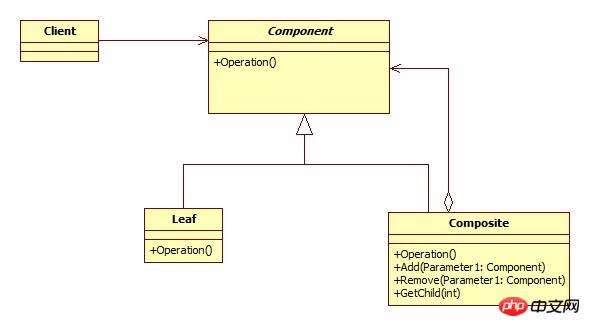Java中组合模型之对象结构模式的实例分析
这篇文章主要介绍了Java 中组合模型之对象结构模式的详解的相关资料,希望通过本文能帮助到大家理解应用对象结构模型,需要的朋友可以参考下
Java 中组合模型之对象结构模式的详解
一、意图
将对象组合成树形结构以表示”部分-整体”的层次结构。Composite使得用户对单个对象和组合对象的使用具有一致性。
二、适用性
你想表示对象的部分-整体层次结构
你希望用户忽略组合对象与单个对象的不同,用户将统一使用组合结构中的所有对象。
三、结构

四、代码
public abstract class Component {
protected String name; //节点名
public Component(String name){
this.name = name;
}
public abstract void doSomething();
}public class Composite extends Component {
/**
* 存储节点的容器
*/
private List<Component> components = new ArrayList<>();
public Composite(String name) {
super(name);
}
@Override
public void doSomething() {
System.out.println(name);
if(null!=components){
for(Component c: components){
c.doSomething();
}
}
}
public void addChild(Component child){
components.add(child);
}
public void removeChild(Component child){
components.remove(child);
}
public Component getChildren(int index){
return components.get(index);
}
}public class Leaf extends Component {
public Leaf(String name) {
super(name);
}
@Override
public void doSomething() {
System.out.println(name);
}
}public class Client {
public static void main(String[] args){
// 构造一个根节点
Composite root = new Composite("Root");
// 构造两个枝干节点
Composite branch1 = new Composite("Branch1");
Composite branch2 = new Composite("Branch2");
// 构造两个叶子节点
Leaf leaf1 = new Leaf("Leaf1");
Leaf leaf2 = new Leaf("Leaf2");
branch1.addChild(leaf1);
branch2.addChild(leaf2);
root.addChild(branch1);
root.addChild(branch2);
root.doSomething();
}
}
输出结果:
Root
Branch1
Leaf1
Branch2
Leaf2以上是Java中组合模型之对象结构模式的实例分析的详细内容。更多信息请关注PHP中文网其他相关文章!

热AI工具

Undresser.AI Undress
人工智能驱动的应用程序,用于创建逼真的裸体照片

AI Clothes Remover
用于从照片中去除衣服的在线人工智能工具。

Undress AI Tool
免费脱衣服图片

Clothoff.io
AI脱衣机

Video Face Swap
使用我们完全免费的人工智能换脸工具轻松在任何视频中换脸!

热门文章

热工具

记事本++7.3.1
好用且免费的代码编辑器

SublimeText3汉化版
中文版,非常好用

禅工作室 13.0.1
功能强大的PHP集成开发环境

Dreamweaver CS6
视觉化网页开发工具

SublimeText3 Mac版
神级代码编辑软件(SublimeText3)
 突破或从Java 8流返回?
Feb 07, 2025 pm 12:09 PM
突破或从Java 8流返回?
Feb 07, 2025 pm 12:09 PM
Java 8引入了Stream API,提供了一种强大且表达力丰富的处理数据集合的方式。然而,使用Stream时,一个常见问题是:如何从forEach操作中中断或返回? 传统循环允许提前中断或返回,但Stream的forEach方法并不直接支持这种方式。本文将解释原因,并探讨在Stream处理系统中实现提前终止的替代方法。 延伸阅读: Java Stream API改进 理解Stream forEach forEach方法是一个终端操作,它对Stream中的每个元素执行一个操作。它的设计意图是处
 Java程序查找胶囊的体积
Feb 07, 2025 am 11:37 AM
Java程序查找胶囊的体积
Feb 07, 2025 am 11:37 AM
胶囊是一种三维几何图形,由一个圆柱体和两端各一个半球体组成。胶囊的体积可以通过将圆柱体的体积和两端半球体的体积相加来计算。本教程将讨论如何使用不同的方法在Java中计算给定胶囊的体积。 胶囊体积公式 胶囊体积的公式如下: 胶囊体积 = 圆柱体体积 两个半球体体积 其中, r: 半球体的半径。 h: 圆柱体的高度(不包括半球体)。 例子 1 输入 半径 = 5 单位 高度 = 10 单位 输出 体积 = 1570.8 立方单位 解释 使用公式计算体积: 体积 = π × r2 × h (4
 PHP与Python:了解差异
Apr 11, 2025 am 12:15 AM
PHP与Python:了解差异
Apr 11, 2025 am 12:15 AM
PHP和Python各有优势,选择应基于项目需求。1.PHP适合web开发,语法简单,执行效率高。2.Python适用于数据科学和机器学习,语法简洁,库丰富。
 PHP:网络开发的关键语言
Apr 13, 2025 am 12:08 AM
PHP:网络开发的关键语言
Apr 13, 2025 am 12:08 AM
PHP是一种广泛应用于服务器端的脚本语言,特别适合web开发。1.PHP可以嵌入HTML,处理HTTP请求和响应,支持多种数据库。2.PHP用于生成动态网页内容,处理表单数据,访问数据库等,具有强大的社区支持和开源资源。3.PHP是解释型语言,执行过程包括词法分析、语法分析、编译和执行。4.PHP可以与MySQL结合用于用户注册系统等高级应用。5.调试PHP时,可使用error_reporting()和var_dump()等函数。6.优化PHP代码可通过缓存机制、优化数据库查询和使用内置函数。7
 创造未来:面向零基础的 Java 编程
Oct 13, 2024 pm 01:32 PM
创造未来:面向零基础的 Java 编程
Oct 13, 2024 pm 01:32 PM
Java是热门编程语言,适合初学者和经验丰富的开发者学习。本教程从基础概念出发,逐步深入讲解高级主题。安装Java开发工具包后,可通过创建简单的“Hello,World!”程序实践编程。理解代码后,使用命令提示符编译并运行程序,控制台上将输出“Hello,World!”。学习Java开启了编程之旅,随着掌握程度加深,可创建更复杂的应用程序。









